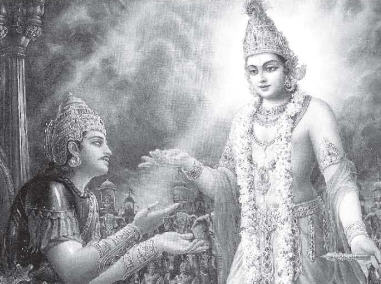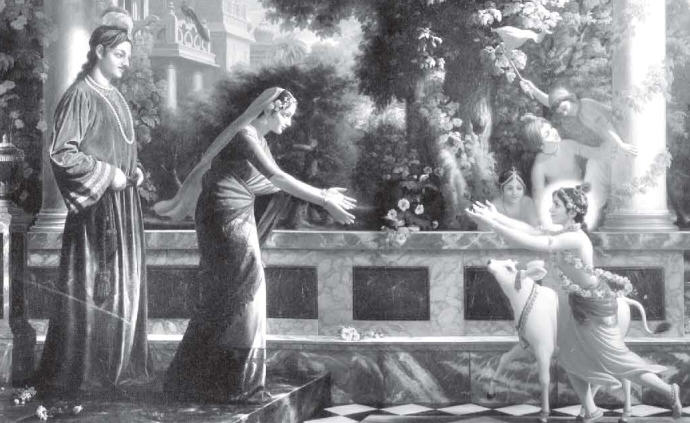Unlike ordinary mortals, Krishna’s appearance in this world is
transcendental and has a definite mission.
transcendental and has a definite mission.
Purpose of Krishna’s Descent

“Although I am unborn and My transcendental body never deteriorates, and although I am the Lord of all living entities, by My internal energy I still appear in every millennium in My original transcendental form.”
(Bhagavatam 10.27.9)
Purport: The Lord has spoken about the peculiarity of His birth: although He may appear like an ordinary person, He remembers everything of His many, many past “births,” whereas a common man cannot remember what he has done even a few hours before. . . The Lord says that He appears in His own body. He does not change His body, as the common living entity changes from one body to another. Whenever He appears, He does so in the same original body, by His internal potency. Although He appears in the same transcendental body and is Lord of the universe, it still appears that He takes His birth like an ordinary living entity. . . But astonishingly enough He never ages beyond youth. At the time of the Battle of Kurukshetra, He looked just like a young man twenty or twenty-five years old. Neither His body nor His intelligence ever deteriorates or changes.
Who can Become Krishna’s Parents?
Drona and Dhara are the eternal father and mother of Krishna. Whenever there is a necessity of Krishna’s appearance, Drona and Dhara appear first, and then Krishna appears. Krishna says in Bhagavad-gita that His birth is not ordinary (janma karma ca me divyam [Gita 4.9]).
Before Krishna’s appearance, Drona and Dhara appear in order to become His father and mother. It is they who appear as Nanda Maharaja and his wife, Yashoda. In other words, it is not possible for a sadhana-siddha living being to become the father or mother of Krishna, for Krishna’s father and mother are already designated.
(Bhagavatam 10.8.49, purport)
For Liberating the Conditioned Souls
Everyone must understand Krishna’s activities (janma karma ca me divyam [Gita 4.9]). If one understands the purpose of Krishna’s coming to this earth and performing His activities, one is immediately liberated. This liberation is the purpose of the creation and Krishna’s descent upon the surface of the earth.
(Bhagavatam 9.24.59, purport)
No Ordinary Birth
The word divyam means transcendental. His activities are not in any way ordinary. Even today, in India, at the end of August the people are accustomed to celebrating Krishna’s birthday, regardless of sect, just as in the Western world Jesus Christ’s birthday is celebrated at Christmas. Krishna’s birthday is called Janmastami, and in this verse Krishna uses the word janma in referring to “My birth.” Because there is birth, there are some activities. Krishna’s birth and activities are transcendental, which means they are not like ordinary births and activities.
(On the Way to Krishna, Chapter 2)
All Tattvas Integrated in Krishna
In regard to Lord Krishna’s appearance in the womb of Devaki, Brahma played a part also because on the bank of the milk ocean he requested the Supreme Personality of Godhead to appear. A part was also played by Baladeva, the first expansion of Godhead. Similarly, Yogamaya, who appeared as the daughter of mother Yashoda, also played a part. Thus jiva-tattva, visnu-tattva and sakti-tattva are all integrated with the Supreme Personality of Godhead, and when Krishna appears, He appears with all His integrated parts.
(Bhagavatam 10.2.9, purport)
Perfect Social and Environmental Harmony

On the occasion of Lord Krishna’s birth, seasonal changes took place throughout the entire universe. Krishna was born during the month of September, yet it appeared like springtime. The atmosphere, however, was very cool, although not chilly, and the rivers and reservoirs appeared just as they would in sarat, the fall. Lotuses and lilies blossom during the day, but although Krishna appeared at twelve o’clock midnight, the lilies and lotuses were in bloom, and thus the wind blowing at that time was full of fragrance. Because of Kamsa’s disturbances, the Vedic ritualistic ceremonies had almost stopped. The brahmanas and saintly persons could not execute the Vedic rituals with peaceful minds. But now the brahmanas were very pleased to perform their daily ritualistic ceremonies undisturbed. The business of the asuras is to disturb the suras, the devotees and brahmanas, but at the time of Krishna’s appearance these devotees and brahmanas were undisturbed.
(Bhagavatam 10.3.1–5)
Krishna’s appearance in the land of Vraja indicated that the chief goddess of fortune, Radharani, would also appear there very soon.
(Bhagavatam 10.5.18, purport)
Krishna’s appearance on this planet like a human being makes us more fortunate than the demigods in the higher planets, and therefore Maharaja Parikshit was very much interested in hearing about Him.
(Bhagavatam 10.7.3, purport)
Krishna Appears in this Age of Kali
The Lord says that He incarnates Himself in every millennium. This indicates that He incarnates also in the Age of Kali. As stated in the Srimad-Bhagavatam, the incarnation in the Age of Kali is Lord Caitanya Mahaprabhu, who spread the worship of Krishna by the sankirtana movement (congregational chanting of the holy names) and spread Krishna consciousness throughout India. He predicted that this culture of sankirtana would be broadcast all over the world, from town to town and village to village. Lord Caitanya as the incarnation of Krishna, the Personality of Godhead, is described secretly but not directly in the confidential parts of the revealed scriptures, such as the Upanisads, Mahabharata and Bhagavatam. The devotees of Lord Krishna are very much attracted by the sankirtana movement of Lord Caitanya. This avatara of the Lord does not kill the miscreants, but delivers them by His causeless mercy.
